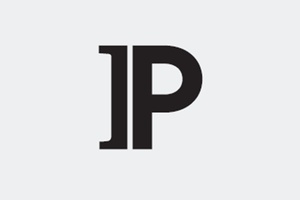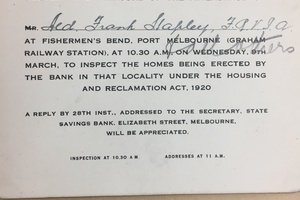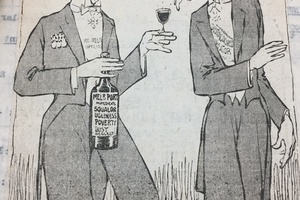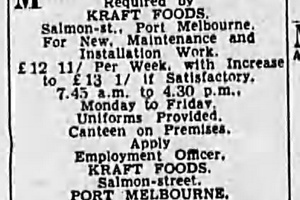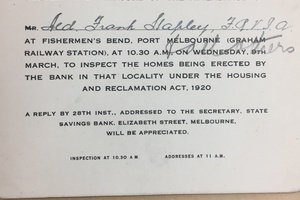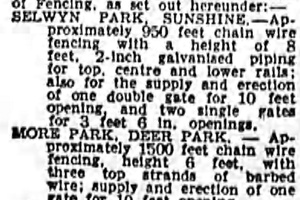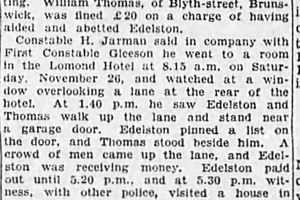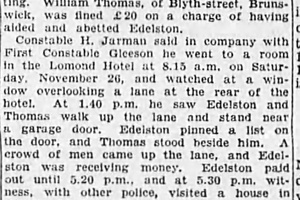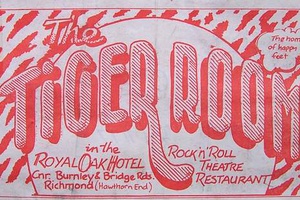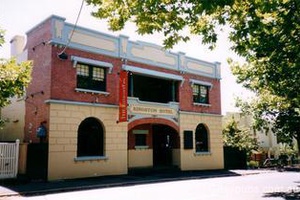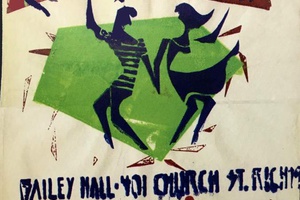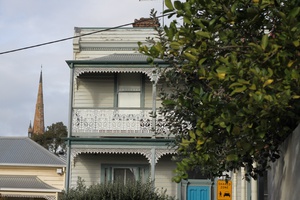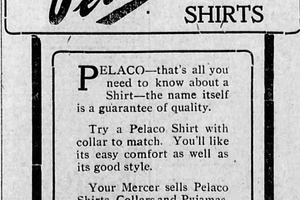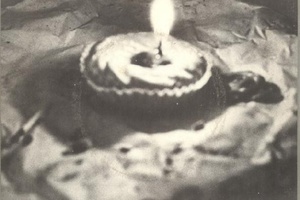This item is a part of these Tours
Dogs in Space: punk Richmond 1978
Jump To TourThis record is a stop on a tour which goes to other places. Pick up the tour by jumping to it from here. Check the map to see where it goes. You can jump back to this place later.
This item is a part of these Tours
Retail, theatre and live music
Jump To TourThis record is a stop on a tour which goes to other places. Pick up the tour by jumping to it from here. Check the map to see where it goes. You can jump back to this place later.
Other content from this author
-
Relocating the railway line
in May, 1929 Melbourne's Metropolitan Town Planning Commission considered 'superseding the existing Port Melbourne railway and locating it in a position which would aid the development of this large area' and 'enable the construction of a parkway drive from the water gateway to the City, which would be unequalled by any in the world.'('Fishermans Bend Spares' file, MPTC Archives, 10291/Box 4 Public Records Office)
davidnichols
-
Tunnel under the river, 1924
On 23 May, 1924 a meeting was held at the Town Hall at which Cr Liston suggested that 'plans should provide for railway communication between Port Melbourne and Williamstown by utilising the Harbour Trust's proposed route with a tunnel under the mouth of the Yarra and connecting with Williamstown in the vicinity of the Pier Station'('Fishermans Bend Spares' file, MPTC Archives, 10291/Box 4 Public Records Office)
davidnichols
-
Tunnel to Williamstown
'It is recommended that a tunnel, to carry vehicular and tramway traffic, be built under the mouth of the river to connect Port Melbourne with Williamstown. The tunnel would be about 70 chains in length with a grade of 1 in 25. Entrance would be made on the 3-chain road in the area to be reclaimed on the Port Melbourne side with an exit at the intersection of Douglas Parade and Stevedore Street' - Notes from Conference with Williamstown and Footscray City Councils and the Braybrook Shire Council - Footscray Town Hall 3 June 1926
davidnichols
-
The Opening of the State Bank Houses
Metropolitan Town Planning Commission Archives, Public Records Office of Victoria
davidnichols
-
New Road Planned from Port Melbourne to the City
In the 1920s there was considerable agitation to replace the railway line with an impressive and grand avenue fit for visitors. This cartoon sums up some of the feelings about Port Melbourne in 1928
davidnichols
-
Prohasky Street
William Henry Prohasky (1856-1937) was a Melbourne-based grocer who entered local politics in the 1880s and served as Mayor of Port Melbourne from 1888-89. He was bankrupted in 1893, as were many in the 1890s depression, and retired from public life thereafter. The Port Melbourne Standard for 5 July 1913 announces council's intention to build a street named in his honour, however, as this is 'from Williamstown Road to the shore', it is not the same Prohasky Street we see today.
davidnichols
-
James Ker Beck Plummer
A Melbourne solicitor, Plummer was first elected councillor for Port Melbourne in 1866 and served as mayor 1885-86. This street, and those surrounding which were also named for councillors of the late 19th century, were created just before the First World War.
davidnichols
-
Death of Him Fung
The body of Him Fung, a cook from Echuca who had lived in Australia for up to twenty years, was found in the Government Pit on the morning of 24 November 1914 by William Schofield while digging out sand. Him Fung had, detectives concluded, experienced 'rough handling prior to death' (death was caused by 'haemorrhage and shock') and had been seen in the company of 'some Chinese sailors' the previous night - possibly from the crew of the Navarino, which was then anchored 'about 40 yards from the spot where he was found thrust into the ground'. There were suggestions that Him Fung had attempted to sell opium supplied by Navarino crew, and also that he may have alerted police to the possession of this drug amongst crew members (two sailors were fined for this offence). He had been a member of the Chinese Masonic Society: a badge found on his body led detectives to the Society and thence to his friend Charlie Tung, who identified him. 'The circumstances of the tragedy are surrounded with so much mystery that it is doubtful if the matter will ever be cleared up,' opined the Adelaide Observer.
davidnichols
-
Invite to view state savings bank house construction, 1927
From the Public Records Office
davidnichols
-
The Tiger Lounge
Laurie Richards operated the Tiger Lounge (also known sometimes as the Tiger Room) in the Royal Oak Hotel, Bridge Road Richmond in 1978. Within six months the Age was claiming that it was amongst the ‘best of Melbourne’s rock pubs,’ alongside the London Tavern, Caulfield; Martinis, Carlton and the Prospect Hill Hotel (‘Rock, Folk and all that Jazz’ Age 9 June 1978 p. 41). Groups that played there included the Autodrifters (Friday 6 January); Rose Tattoo (Friday 13 Jan); Red Hot Peppers (Friday 27 January); Jab (Friday 10 February) The Sports (Saturday 24 March) and Sidewinder (Friday 13 May). Richards left to run the Crystal Ballroom in the Seaview Hotel in St Kilda at the beginning of 1979. By 1980, the venue was known as The Bottom Line; in 1981 it had reverted to the Tiger Lounge name but was described in the Age as 'a haunt for aggressive drinkers' (6 November 1981, p. 44). A video circa 1978 of the Boys Next Door performing Shivers - a song which appears twice in Dogs in Space, once sung by Nick Cave in the Boys Next Door, and once sung by Marie Hoy - can be found at https://vimeo.com/130398698
davidnichols
-
Kingston Hotel, 55 Highett St Richmond
The Kingston was a significant early player in the development of inner-city pubs as music venues. There was a Kingston Hotel in Richmond as early as 1856 (The Age, 16 April 1856 p. 3) and the hotel has played a substantial role in the local community since that time. In the mid-1970s the Kingston took on a new role when the Pelaco Brothers - originally, Stephen Cummings (vocals) Peter Lillie (vocals, guitar) Joe Camilleri (vocals, saxophone) Johnny Topper (bass) Karl Wolfe (drums) and Chris Worrall (guitar) - started operating the hotel as a music venue. As well as creating a new musical aesthetic, in hindsight, termed 'ockerbilly', the group were an extraordinary launchpad, and four of the members went on to be the nucleus of their own bands and to have successful careers thereafter. As well as the Pelaco Brothers and their various offshoot bands (for instance, the Autodrifters, featuring Lillie, Topper and Wolfe, who played there on Saturday 4 February 1978) the hotel hosted shows by Skyhooks, Crossfire, One Nite Stand and News. Joe Camilleri had a small guest role in Dogs in Space as the angry 'ethnic' neighbour, 'Terry Towling Man'.
davidnichols
-
Bailey Hall, 401 Church Street Richmond
The Soldier's Memorial, RSL or Bailey Hall at 401 Church Street Richmond was the venue for a key moment in Melbourne's punk/new wave history: it was the location of 'Son of Punk Gunk', the second 'Punk Gunk' festival, on Tuesday 28 February 1978. While the first was a more spontaneous affair, this was to be a co-ordinated event, though both were conceived as art happenings. However, the Boys Next Door and Teenage Radio Stars pulled out late in the piece - apparently on advice, request, or demand of their new record company, Suicide. They were replaced by The Proles. There is no record of the Bailey Hall being an ongoing music venue. Since the 1980s the building has been a health facility.
davidnichols
-
18 Berry St Richmond
Henry Frencham, who made his fortune in gold and is described in some quarters as the founder of Bendigo, commissioned the building of 18 Berry Street in 1886. In the late 1970s and early 1980s the house was a group household shared by, amongst others, members of the new wave band The Ears. In 1986, the house's centenary year, it was used in the filming of Richard Lowenstein's Dogs in Space, based in large part on the house's share house years in the late 1970s.
davidnichols
-
MCG gate 3: the 'Bowie Queue(s)' 1978
On Saturday 23 September 1978, tickets went onsale for David Bowie shows in Melbourne, which had extraordinary significance for Melbourne punk and new wave music in the following years (to the present day). Bruce Butler writes extensively (and with many great pictures!) of the significance of the 'Bowie queue' at http://www.bowiedownunder.com/lowheroes/14.html - see also the postscript noting that 'Berry Street and the Bowie queue did not co-exist as they did in the movie. This was a plot convenience (Berry Street came later)... [but] this was where many of the friendships were first established, eventually leading to the Richmond terrace house and several of the friendships that still exist today.' Note there were two 'Bowie queues' - one for tickets, and one for the actual show! Both were feats of endurance.
davidnichols
-
Pelaco Factory 21 Goodwood St Richmond
Established in 1906 by James Pearson and James Law, Pelaco (and its advertising based around an often pantsless Aboriginal man, 'Pelaco Bill', created in 1911 from the image of the Geelong-based Mulga Fred) was already a sufficiently well-known brand in 1922 that the company was able to effectively prevent G. E. Crawford of South Richmond from manufacturing boot polish with the same name (The Age, 18 May 1922, p. 6). In 1928 the Pelaco shirt ('and collar') manufacturer had completely relocated from Gipps St Richmond and Gertrude Street Fitzroy to purpose-built premises in Goodwood St. The sign - now heritage-listed - is visible from 18 Berry St and appears prominently in the film Dogs in Space. There is a tie-in between this sign and the fact that Joe Camilleri, who plays the minor role of 'Terry Towling Man' in the film, was once singer and saxophonist in the group The Pelaco Brothers, who ran a venue at the Kingston Hotel in the mid-1970s.
davidnichols
-
Richmond Recorders
Richmond Recorders was a popular recording studio in the late 70s and early 80s; the Ears, the band that inspired the group in Dogs in Space, recorded its second single 'Scarecrow' there in 1980. Six years later, Ollie Olsen recorded half of the Dogs in Space soundtrack album, including Michael Hutchence's top 20 hit single 'Room for the Memory,' there. A number of other major albums of the period - including Men at Work's Grammy Award-winning Business as Usual and some of the Birthday Party's best records - were recorded at Richmond Recorders. The Young Talent Team recorded songs at the studio on a weekly basis for its TV show.
davidnichols
-
Richmond Recorders
Richmond Recorders was a popular recording studio active through the late 1970s and into the 90s. Much of the Dogs in Space soundtrack was recorded here. News, an early punk group, also recorded a single here - the band's first drummer was John Murphy, who appears in Dogs in Space in multiple roles as well as on the soundtrack.
davidnichols
